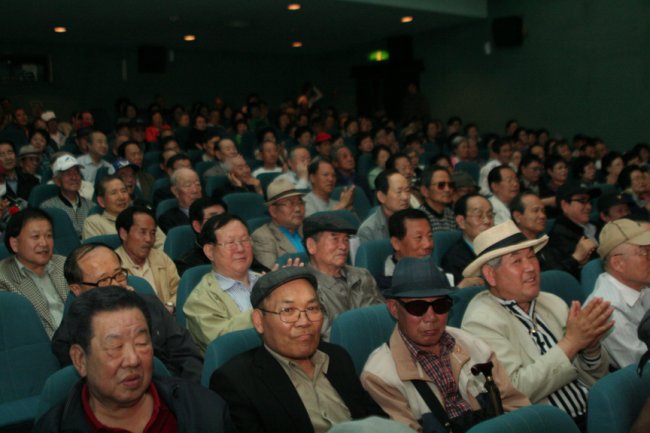Jang Deok-ho’s movie night out started way before sunset.
The 74-year-old walked two hours to Hollywood Silver Cinema, a small, old-fashioned cinema in Seoul’s Jung-gu district, where his choice of movie was up for a 6:20 p.m. showing.
 |
An elderly audience enjoys watching a live performance at Hollywood Silver Cinema, Jongno-gu, Seoul.(Hollywood Silver Cinema) |
“I like walking and I like watching movies,” Jang said casually, glancing at the poster for the night’s film -- the 1961 American classic “The Hustler”
In the waiting area sat an elderly couple, clasping their hands tightly. A gray-haired woman purchased her ticket from a small box office, manned by a staff member looking as old as the guest.
In the era of 4-D and 5-D cinemas and multiplex chains, this unassuming, one-screen theater boasts one of the country’s highest seat occupancies and probably the most loyal clientele.
“We’re a single-screen theater with just 300 seats,” said Kim Eun-ju, the theater’s CEO. “But our seat occupancy rate reaches nearly 80 to 90 percent on average.”
Out of its four daily showings, one or two time slots -- especially the one around lunchtime -- are sold out almost every day, she explained.
It is a pretty incredible feat, given that average occupancy at local multiplex chains stands somewhere between 20 and 30 percent.
Hollywood Silver Cinema opened in 2009 on the fourth floor of Nakwon Arcade, where the Hollywood Theater used to lure youngsters with American movies.
Targeting the now gray-haired movie fans who still remember the old Hollywood Theater, Kim started to screen classic movies.
 |
The Hollywood Silver Cinema in Jongno-gu, Seoul.(Hollywood Silver Cinema) |
“The films we select are mostly from the 1940s to ’70s that were ranked first to fifth at the box office at the time,” she said.
Past selections have included “Gone with the Wind” (1939), “Ben-Hur” (1959), “Dr. Zhivago” (1965) and “Cinema Paradiso” (1988).
“We do show recent releases from time to time. Films that we think could appeal to senior citizens such as ‘My Love, Don’t Cross That River’ (2014) or ‘Masquerade’ (2012).”
A short walk from Tapgol Park, the foremost gathering place for seniors in Seoul, the place quickly became a new hangout for old folks.
In its first few months, the theater had less than 100 daily admissions. But the number increased rapidly through word of mouth. In 2010, around 100,000 people visited, but by 2014 the tally had reached 250,000. Kim expects the upward trend to continue.
Inspired by the theater’s success, similar cinema ventures have sprung up in Seoul, including Myungbo Silver Theater and Cheongchun Cinema in the central district of Jung-gu.
Now, silver cinemas are spreading to other cities, including Ansan, Gyeonggi Province; Incheon; and Daegu.
So, what can the success of silver cinema be attributed to?
“The cheap price adds to the fun,” said 75-year-old Lee Chae-young, another regular at Hollywood Silver Cinema. “Also, being able to watch classics and old romantic films is the reason I come here.”
She even has the theater’s website listed on her smartphone’s favorites to check the timetable.
A ticket at Hollywood cinema is 2,000 won ($2) per person aged 55 and up. Visitors under 55 must pay 7,000 won, slightly less than the 9,000 won to 10,000 won that a typical multiplex chain charges.
The price hasn’t changed since the theater first opened. Operating the theater with such low ticket prices was difficult, says the CEO. Nevertheless, she decided earlier that ticket sales should not be the main source of revenue.
To fill the slack, she turned to big companies and the government for donations and advertisements. Large companies, including SK Chemical and Yuhan-Kimberly, and Seoul City are among its donors.
“When (people from) donor companies visit our theater, they are deeply moved and decide to continue their support,” said Kim. “Without the sacrifice of these generations, large local companies wouldn’t be what they are now. The companies can pay them back through funding these kinds of projects.”
The price is a key factor, but culture critics point to the underlying needs of the elderly, which often get overlooked.
Silver cinemas are not just places to watch movies, but are becoming gathering points for seniors, who otherwise only have public parks or community centers to visit.
While the number of those aged 65 or older is growing rapidly -- the age group is expected to rise to 20 percent of the total population by 2026 from 12.6 percent last year -- indoor spaces where they can have fun and engage in cultural activities are scarce.
Against this backdrop, silver cinemas offer much more than just filming-viewing.
Hollywood cinema holds various events, including concerts. Renowned “teuroteu” singers, decked out in sparkly sequined jackets, sing their beloved tunes to a full house. Audience members clap, sing and dance along with the music and relive past memories.
The theater also operates a cafe, Adding to Memories, right around the corner. An old-fashioned metal lunch box and janchi guksu, a warm, light broth noodle soup, is priced at 3,000 won and coffee is 2,000 won. The DJ plays LP versions of songs requested by the elderly citizens inside the cafe. “People go dine and hang out before or after the movie,” said Kim, who mentioned that the restaurant is also a hot place for elderly dating.
By Ahn Sung-mi (
sahn@heraldcorp.com)









